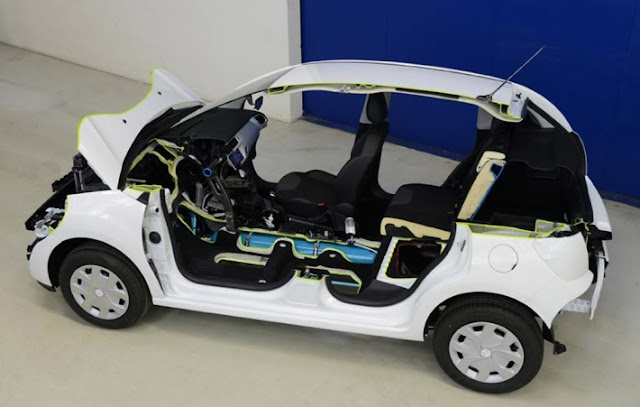Prototype hybrid cars running on compressed air expected by 2016
Those in love know the sensation of walking on air. So perhaps it's no surprise that the romantic French would develop a car that gets amazing gas mileage by
running on air.
Getting a car to move at respectable speeds with compressed air is hard. Very hard.
“Hybrid Air” is a concept hybrid car that uses a “compressed air tank mounted in the central transmission tunnel to turn a hydraulic motor” instead of an electric battery, according to
Green Car Reports.
French automaker Peugeot Citroen's latest automotive innovation named "Hybrid Air" operates on compressed air, gasoline or a combination of the two, DigitalTrends.com reports. At speeds above
43 mph (70 kilometers per hour), the car uses a
standard three-cylinder gasoline engine with an automatic transmission.

There have been prototype
cars since the 1920s, with compressed air used in torpedo propulsion.

when the driver slows down below 43 mph, as in typical city driving, the car uses compressed air to power a hydraulic motor, allowing the gasoline engine to shut down. When
climbing a steep hill or accelerating, the two powertrains work together to give the car the extra oomph it needs, according to MotorAuthority.com.
A car with a compressed air tank is also much lighter. According to MotorAuthority, the Hybrid Air tank would only add about
220 pounds to the car, compared to the 400-pound batteries found in hybrid cars such as the Chevy Volt.
Refueling could be done at home using an air compressor or at service stations. The energy required for compressing air is produced at large centralized plants,
making it less costly and more effective to manage carbon emissions than from individual vehicles. However,
compressors for 250-300 bars are not normally available for home standard utilization, considering the danger inheritant to these pressure levels.

Compressed air engines reduce the cost of vehicle production, because there is no need to build a cooling system, spark plugs, starter motor, or mufflers.
The rate of
self-discharge is very low opposed to batteries that deplete their charge slowly over time. Therefore, the vehicle may be left unused for longer periods of time than electric cars.
Expansion of the compressed air lowers its temperature; this may be exploited for use as air conditioning.
Some mechanical configurations may
allow energy recovery during braking by compressing and storing air.
Sweden’s Lund University reports that buses could see an improvement in fuel efficiency of up to 60 percent using an air-hybrid system But this only refers to hybrid air concepts (due to recuperation of energy during braking), not compressed air-only vehicles.
The principal disadvantage is the indirect use of energy. Energy is used to compress air, which in turn provides the energy to run the motor.
Any conversion of energy between forms results in loss.
For conventional combustion motor cars, the energy is lost when chemical energy in fossil fuels is converted to mechanical energy, most of which goes to
waste as lost heat.
For compressed-air cars, energy is lost when chemical energy is converted to electrical energy, when electrical energy is converted to compressed air, and then when the compressed air is converted into mechanical energy.

When
air expands in the engine it cools dramatically and must be heated to ambient temperature using a heat exchanger.
The heating is necessary in order to obtain a significant fraction of the theoretical energy output. The
heat exchanger can be problematic: while it performs a similar task to an intercooler for an internal combustion engine, the temperature difference between the incoming air and the working gas is smaller.
In heating the stored air,
the device gets very cold and may ice up in cool, moist climates.

This also leads to the necessity of completely dehydrating the compressed air. If any humidity subsists in the compressed air, the engine will stop due to inner icing.
Removing the humidity completely requires even additional energy that cannot be reused and is lost.
The AirCar would not be in vain
What makes Peugeot's car greener than your average Prius is a technology known as "regenerative braking," DigitalTrends.com reports. In regenerative braking, the car's compressed air storage tanks are refilled with air
by harnessing the energy created every time the driver brakes energy that's usually just dissipated as heat.
And because the car uses no heavy batteries to store electricity, it's lighter than many hybrid cars offered today. Peugeot's Hybrid Air car is currently a concept vehicle, but
the company expects to have the vehicle available for purchase by 2016.
This unique hybrid system will give the passenger car a whopping
117 mpg (2 liters per 100 kilometers), according to the Daily Mail.
 Developers and manufacturers
APUQ (Association de Promotion des Usages de la Quasiturbine)
Developers and manufacturers
APUQ (Association de Promotion des Usages de la Quasiturbine)
Main article: Motor Development International
Tata Motors
Air Car Factories SA
Etc.,
 Referred by 1:
Referred by 2:
Referred by 3:
Referred by 1:
Referred by 2:
Referred by 3:
















.JPG)


















